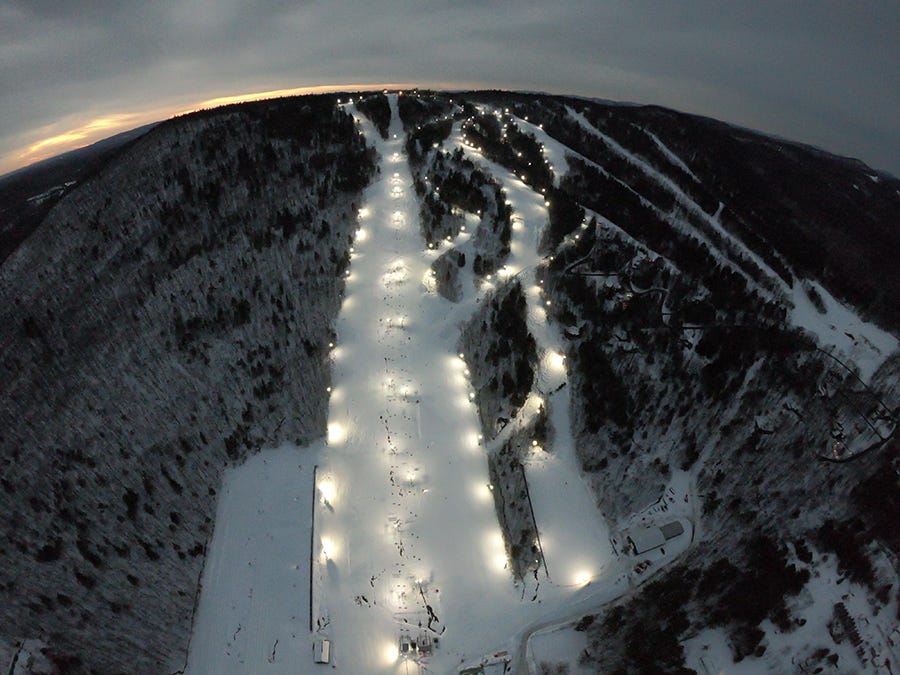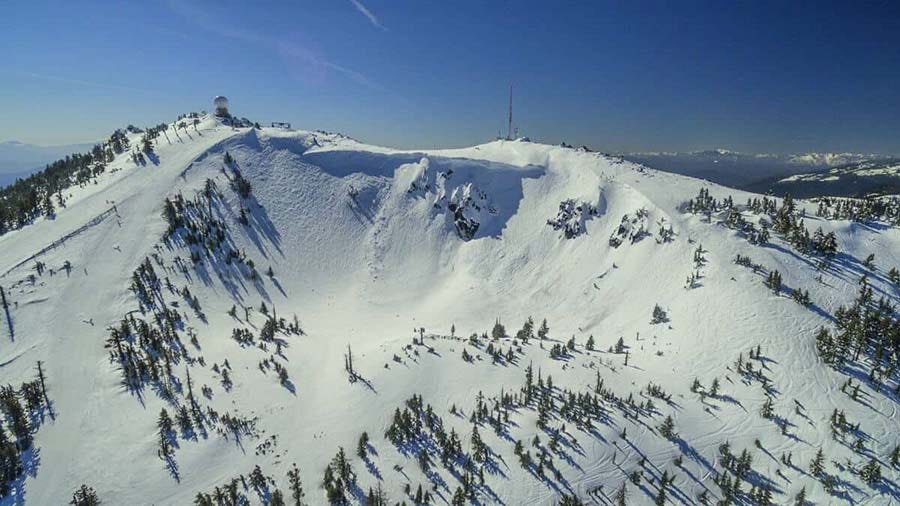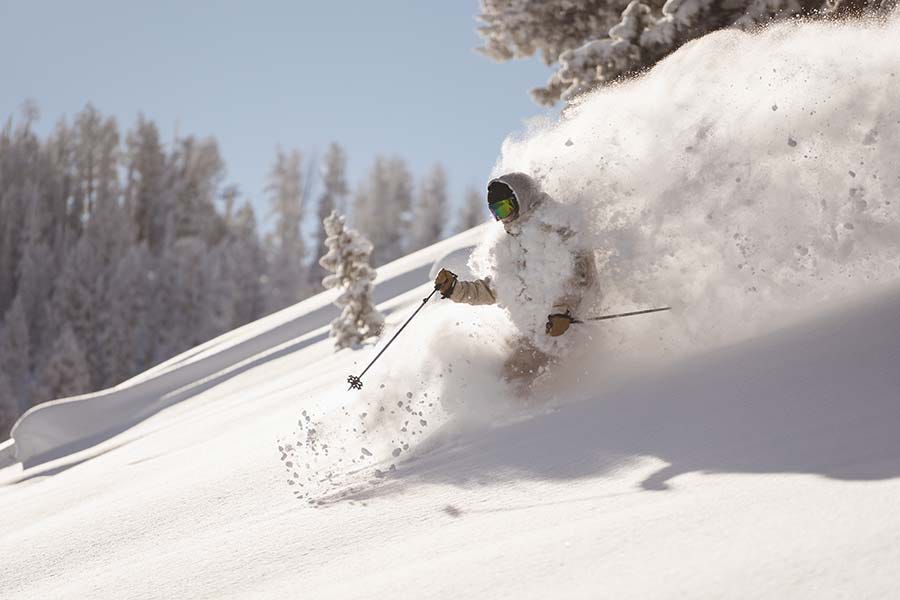Indy Pass Adds Powder Mountain, West Mountain, Mount Ashland for 2021-22 Season
Prices rise to $279 for Indy Pass and $379 for Indy Plus Pass as coalition grows to 66 ski areas
April 27, 2021
Indy Pass announced its 2021-22 pricing and partner lineup today, significantly increasing prices and adding three new ski areas, including the monster Powder Mountain in Utah. All 63 partners from the 2020-21 ski season will return.
The baseline Indy Pass, which will grant two days of access at 66 ski areas in the U.S. and Canada, will cost $279, a nearly 40 percent increase from its $199 early-bird rate last season. Kids passes will rise nearly 20 percent, from $99 to $119. Season passholders at any Indy Pass mountain will be able to add on the Indy Pass for $189 ($89 for kids), up from $129 last season.
As of today, 22 ski areas plan to black out select dates, up from just four last season. Blackout periods will vary widely, from just four holiday weekend days to 37 days that sprawl across holidays and all midwinter weekends (details below). The Indy+ Pass will have no blackouts and will be $379 ($169 for kids), up from $299 last season. The Indy+ add-on will be available to season passholders for $289 ($139 for kids).
All passes are available immediately. A payment plan is available for a limited time. Indy will not revive its Keep America Skiing program, a Covid-era initiative that credited skiers with a percentage off 2021-22 passes if they skied three or fewer days during the 2020-21 ski season. Unused passes will earn a 10 percent credit toward the purchase of a 2022-23 Indy Pass, and skiers can buy a $25 protection plan that grants a full, no-questions-asked refund on unused passes for one year after the purchase date.
The addition of Utah’s Powder Mountain gives Indy Pass a Western anchor equal to their addition of Jay Peak in the East, a significant and sizeable ski area with unquestioned snow and terrain quality. This addition continues Indy’s evolution into a destination product that can act as a true alternative to the Epic and Ikon passes.
Here’s a bit more about the new partners and price tiers, and what these changes mean for skiers and for the Indy Pass:
Big price increases, but much bigger access
The Indy Pass launched in August 2019 with 34 partner resorts. It cost $199. By the following spring, it had grown to 52 ski areas, including regional standouts Cannon, Lutsen, and Granite Peak. And yet, the price stayed the same.
It couldn’t stay there forever, particularly as the pass added more name-brand resorts with higher day ticket prices. For each skier visit, Indy pays the resort a percentage of its advertised day-ticket price, or rack rate. To entice higher-quality mountains to join and stay on the pass, Indy has to make sure that that percentage, or “yield,” doesn’t drop too low. Thus, a higher pass price.
It’s still quite affordable. Standard Indy Passes for two adults and two children under 12 would add up to $796. Indy+ Passes would be $1,096. Compare this to four Epic ($2,364), Epic Local ($1,772), Ikon ($2,436 or $2,236 with a renewal discount), or Ikon Base ($1,816 or $1,656 with a renewal discount) passes. It even compares favorably to a family’s worth of Vail’s Northeast Value ($1,564) and Northeast Midweek ($1,324) passes.
Still, it’s easy to run into problems with Indy-to-Epic/Ikon comparisons. Those are season pass products. Indy is a frequency product. For families who must ski each weekend at the same mountain, Indy is not going to work. But for families with the flexibility to travel who are exasperated by the high cost of day tickets, the pass is a miracle. A family of four who lives in, say, Massachusetts could easily ski 20 (or more) days on their passes over the course of a season. That’s $9.95 per lift ticket with Indy Passes, or $13.70 with Indy+ Passes. Combine that with seasonal gear rentals for the kids, a brown-bag mentality, and some creative lodging choices, and you have a ski family that otherwise may not have been.
As Indy adds larger and more built-out mountains, it’s getting harder to argue that the overall quality of Epic or Ikon resorts is worth the differential in price for people who don’t necessarily need a season pass at one ski area. Indy’s lineup in the Midwest – with regional giants like Granite Peak, Lutsen, and Crystal – is absolutely unchallenged by any other multipass. Indy’s Northeast lineup features the best ski area in Vermont (Jay Peak), arguably the best in New Hampshire (Cannon), and a host of others that can flex to any kind of ski day you’re looking for: Waterville Valley, Saddleback, Magic, Bolton Valley, Berkshire East, Black Mountain, etc. Vail and Alterra have a presence in the Northern Rockies and Pacific Northwest, but mostly by staking out the largest resorts. Indy Pass filled in the blanks in between, and they’re pretty good blanks, with big verts, big acreage, and big snowfall (see the Pow Mow section below). For the road-tripper, it’s hard to find a better pass for these three regions, and it’s hard to argue that the current options aren’t worth the higher price.
The Indy+ Pass becomes a real option as blackouts expand significantly
Only a handful of Indy Pass partners opted into blackouts last season, making the Indy+ Pass a niche product with little utility or appeal, particularly for 50 percent more than a standard Indy Pass. This year, the calculation becomes much more complex, as 23 Indy ski areas commit to some set of blackout days along five tiers:
- Tier 1 – January 15-16, February 19-20: Caberfae, Magic
- Tier 2 – Holidays – Dec. 25-31, Jan. 1-2, 15-17, Feb. 19-21: 49 Degrees North, Beaver Mountain, Big Powderhorn, Brundage, Canaan Valley, Crystal, Massanutten, Pine Mountain, Red Lodge, Shanty Creek, Shawnee, Waterville Valley, Winterplace
- Tier 3 – Tier 2 Holidays + Saturdays January 22 – March 5: Granite Peak, Lutsen, Silver
- Tier 4 – Tier 2 Holidays + All Saturdays: White Pass
- Tier 5 – Tier 2 Holidays + All Weekends Jan. 8-March 13, Feb. 16-19: Saddleback, Cannon, Mission Ridge, Powder Mountain
That leaves 43 mountains with no blackouts, including regional giants Jay Peak, Tamarack, and Apex. Still, the breadth and complexity of the limitations is daunting. For skiers with less flexibility but intentions to ski enough to justify the $379 cost, an Indy+ Pass could make a lot of sense and save a lot of hassle.
The blackouts appear to have replaced a less straightforward access-metering tool used last season: limiting Indy Pass tickets. Not every ski area did this, but many did, and it did impact perceptions of the overall utility of the pass. The blackouts, while severe in some cases, are clear and allow passholders to plan with confidence, rather than booking a hotel and later finding that all the Indy Pass reservations for the day have already been claimed. Blackout dates could change. See the most up-to-date tiers and mountains here.
Powder Mountain: a western anchor with massive snowfall
Indy Pass has assembled an impressive roster of bigger-than-you-think ski areas bunched in the Northern Rockies states of Idaho, Wyoming, and Montana: Lost Trail, Red Lodge, Tamarack, Brundage, Silver, and Snow King, among others. Combined with similar offerings in Washington state (Mission Ridge, 49 Degrees North, White Pass), and not unreasonably far over the Canadian border (Apex, Castle), the pass has become a sort of adventure passport for skiers willing to travel and resort-hop through the region.
Powder Mountain becomes the southern anchor of this constellation, a massive and uncrowded snow kingdom stationed north of the increasingly mobbed Wasatch resorts and south of fellow Indy partner Beaver Mountain. The ski area claims to be the largest in the United States, with 8,464 acres and a 3,346-foot vertical drop. All of which is true, but comes with significant asterisks: the lift-served portion of the resort is around 3,000 acres, on a 2,205-foot vertical drop. The rest is guided skiing, which is presumably not included on an Indy Pass ticket.
Still, the place is massive, and one stat requires no asterisk: more than 500 inches of annual snowfall. This is Utah pow without the Salt Lake crowds. That second part requires a bit of a social engineering trick: Powder Mountain limits season pass sales and day tickets, and they will apply this philosophy to Indy Passes as well, limiting tickets to 100 on weekends and holidays and 250 on weekdays. Whether those limits compromise the usability of the pass remains to be seen.
Powder Mountain is a unique ski area. It’s big and varied and interesting, like Park City or Snowbasin or Alta. But it’s not really like any of those places. Most of its lifts are fixed-grip quads. It’s owned by an eclectic group of brollennials who seem more bent on transforming the place into a quasi-public Yellowstone Club than competing with the resorts closer to Salt Lake City. And so far, it has remained outside of any pass partnership.
No longer. This partnership is a nod to the 2021 reality of a consolidating ski industry. It’s hard to stand alone when all your competitors are on a multipass. But it’s also a signal to other large and unaffiliated resorts: Indy Pass is ready. Three or four years ago, it would have been easy to imagine Powder Mountain on the Mountain Collective or Epic passes. Now, Indy, with its approachable pricetag and limited access, seems just right.
West grows Indy’s footprint in the most puzzling ski state in America
New York skiing is hard to understand. It has more ski areas than any other state, but they don’t really make sense. They’re scattered all over the place. Most are at least somewhat challenging to access. A couple are enormous but most are not. Trappings such as high-speed lifts and slopeside lodging are rare. It has the fortune of lake-effect snowbelts tumbling off Lakes Eerie and Ontario, but its largest ski areas sit outside of these. Its appeal as a ski destination is dwarfed by neighboring Vermont, which has fewer than half as many ski areas, but the fortune of seating most of its largest mountains in the places where it actually snows.
That’s the puzzle Indy Pass is trying to solve, with five ski areas scattered across the state. It would be hard to hop from one to the next in, say, a weekend, so they don’t make a lot of sense as a unit. But individually, each of them fits the pass. I’ve been to all of them and they’re all worth a visit. Snow Ridge is a park-at-the-bottom-of-the-lifts anachronism with wooden T-bars and Hall doubles shooting across byzantine terrain piled with more snow than almost anywhere else in the Northeast. Swain has a funky sprawl and plodding vibe that suits its country station. Greek Peak and Catamount are resurgent 1,000-footers undergoing dramatic reorientations under new-ish owners.
So is West. As I wrote recently in my introduction to my podcast conversation with the mountain’s owner/operators, Spencer and Sara Montgomery:
West Mountain is one of the best stories in New York skiing. A decade ago, the place was falling apart. Trails-in-name-only had become overgrown and were rarely open. A handful of homemade mobile snowguns serviced the mountain. A trio of doddering antique chairlifts rose from a cluster of ramshackle or abandoned buildings. Night-lighting was inconsistent and covered only portions of the mountain. The place puttered along on 30,000 skier visits per year. Then the Montgomerys arrived with a new vision and energy, moving their family of six to the base of the mountain and initiating a $17 million gut renovation. Eight years after their arrival, the place is transformed, with a forest of tower guns that can bury the full trail network in a few days, three new lifts, 100 percent night skiing, widened and consistently open ski runs, renovated lodges and cafeterias, and reinvigorated race and after-school programs. And that’s just phase one. The long-term aspiration is to transform West into the sort of ski-and-stay destination that New York is desperately lacking, build an affordable ski academy, and continue expanding the lift and trail network.
This is the kind of mountain that should do well on Indy Pass. It’s close to Saratoga Springs and less than an hour north of Albany. It sits just off the interstate and is probably the easiest ski area to access in New York State. It’s a place that a lot of skiers headed north to Gore have long overlooked, but may be tempted to go to if they have a ticket handy. It’s positioned itself to become the next Jiminy Peak or Holiday Valley – a destination in spite of its smaller size. Indy will help skiers figure that out.

Mt. Ashland adopts an orphan
Perched near Oregon’s southern border, Mt. Ashland is close enough to Interstate 5 that the highway winds through the distant valley on the mountain’s trailmap. And it’s a nice trailmap, with an outsized volume of steeps, including a double-diamond bowl and plenty of glades, dumping off its summit. The ski area is small for Oregon – just 1,150 vertical feet on 240 acres. But that’s plenty for a day or two. And with 265 inches of annual snowfall, there’s plenty of base to keep those bowls and glades interesting.

But back to Interstate 5. America’s top-to-bottom West Coast throughway sews Ashland to fellow Indy partner Mt. Shasta Ski Park, 85 miles to the south. This formerly orphaned Northern California ski area has driven few if any Indy Pass sales, according to Fish. Adding a second driveable mountain will pique some interest among local skiers, who will use up their four days at the two nearby areas and then look to roadtrip up to Hoodoo or beyond for additional days.
Conspicuous free agents remain
Indy Pass has quickly established itself as a must-buy in the Northeast, the upper Midwest, and the Pacific Northwest. Still, a few gaps remain. There’s probably room for a partner or two each in southern California and New Mexico. Pennsylvania has plenty of remaining independents. The lower Midwest has no representation at the moment.
Indy Pass can add those markets or not and it won’t really matter to its long-term viability as a national pass. But it absolutely must establish a presence in Colorado and around Lake Tahoe. There is no shortage of candidates: Loveland, Wolf Creek, Monarch, Purgatory, Sunlight, Mt. Rose, Sierra at Tahoe, Homewood, Diamond Peak, and many more. Many of these are members of the Powder Alliance or other reciprocal ticket coalitions. But so are many current Indy Pass partners, including Mission Ridge, Silver, and White Pass.
They won’t all join Indy, but some of them probably will, and the more Powder Mountain-caliber resorts that sign on, the closer we’ll likely get to seeing that happen.
Posted from The Storm Skiing Journal





